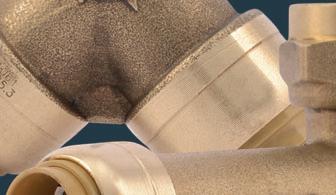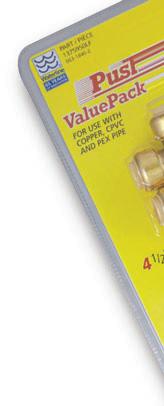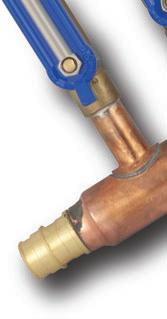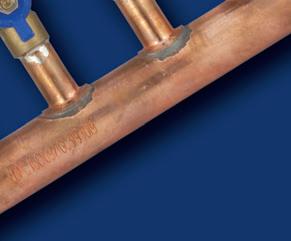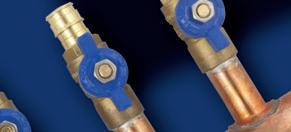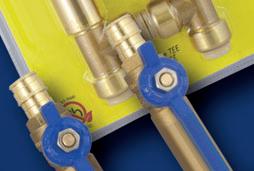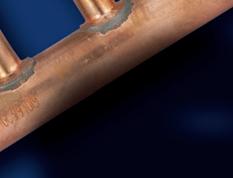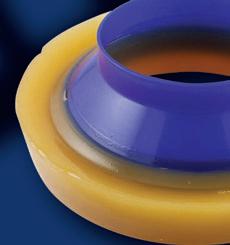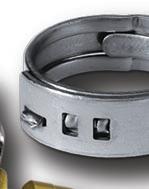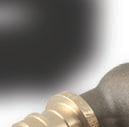










































































































Our publisher was recently asked to speak on a panel to discuss social media in the skilled trades and share some of the best practices to follow for businesses. In lead up to the event, we as a company had many different debates on how our approach has changed over the years.
Most of our social media was developed about five years ago. Since then, we have continued to grow our reach and following. One of the most important lessons we’ve learned over the years, which sounds basic in nature but important nonetheless, is that winging social media just doesn’t work. There needs to be daily activity on your various accounts and the content itself needs to be relevant. We now throw around terms like “social media planning.”
As a media company, social media allows us to share our articles and other content outside our normal publication dates and to a new demographic.
We have seen a shift in how we produce our content, which I highly suspect is due to the pandemic. We are also seeing a shift towards more digital content nowadays.
We are looking at developing projects such as one-day online training conferences, product reviews, on-the-job walk-throughs, and even short training videos. People rely on social media more today than ever before.
Social media doesn’t necessarily have to be just for the larger companies out there. More and more of the smaller contracting companies are turning to social media to share their installations and best practices.

Platforms like TikTok and Instagram are great for sharing those pictures or videos you take during your day that seem to stockpile on your phone. There have been a few profiles that I regularly follow on Twitter that have some interesting conversations. Some are just entertaining and give you something to chuckle and shake your head about.


It can be quite daunting figuring out which platforms your company should join. So, I’d say my best advice for those pondering the idea of joining the social media community is to start out with one of two and go from there. If you want to simply share some fun pictures with your network, then stick to the ones that are best suited for that specific medium. If you are more moved by the written word and would rather express your opinions, again, pick the ones that are more geared toward the type of voice you are looking to create for you company.
And above all else, try and have some fun.
January/February 2023
Volume 33, Number 1 ISSN 1919-0395
Publisher
Mark Vreugdenhil (289) 638-2133 ext.1 Cell: (416) 996-1031 mark@plumbingandhvac.ca
Editor Leah Den Hartogh (289) 638-2133 ext. 2 Cell: (289) 830-1217 leah@plumbingandhvac.ca

Assistant Editor Francesco Lo Presti (289) 638-2133 ext. 3 francesco@plumbingandhvac.ca

Contributing Writers
Glenn Mellors, Greg Scrivener, Michael Ridler, Ron Coleman
Design and Production Tim Norton/Janet Popadiuk production@plumbingandhvac.ca
All articles and photos by Plumbing & HVAC staff unless noted.
PLUMBING & HVAC Magazine is published eight times annually by Marked Business Media Inc. and is written for individuals who purchase/ specify/approve the selection of plumbing, piping, hot water heating, fire protection, warm air heating, air conditioning, ventilation, refrigeration, controls and related systems and products throughout Canada.
Marked Business Media Inc.
286 King Street W, Unit 203, Oshawa, ON L1J 2J9 Tel: (289) 638-2133
Postmaster: Send all address changes and circulation inquiries to: Plumbing & HVAC Magazine, 286 King Street W, Unit 203, Oshawa, Ontario, Canada L1J 2J9. Canadian Publications Mail Sales Product Agreement No. 43029513. Postage paid at Toronto, ON. Annual Subscription Canada: $40.00 plus applicable taxes, single copy $5.00 plus applicable taxes. Annual Subscription United States: $60.00
U.S. Annual Subscription foreign: $90.00 U.S.
Copyright 2023. The contents of this magazine may not be reproduced in any manner without the prior written permission of the Publisher.
A member of:

• Canadian Institute of Plumbing & Heating
• Mechanical Contractors Association of Canada
• Ontario Plumbing Inspectors Association
• American Society of Heating Refrigerating & Air Conditioning Engineers
• Heating Refrigeration and Air Conditioning Institute of Canada
• Refrigeration Service Engineers Society of Canada
Following a six-month investigation, Technical Safety BC has released its findings on the fatal ammonia incident that occurred on May 26 in Kamloops, B.C.
The report, titled “Kamloops Ammonia Release” was based upon evidence presented and available at the time of the investigation, which sought to understand both causal and contributing factors that led to the ammonia release, according to Technical Safety BC.
The incident occurred on May 26 when a crew was in the process of cutting up and disassembling two ammonia refrigeration systems at an Artic Glacier Inc. ice distribution facility located in Mount Pail Industrial Park, located on Tk’emlúps te Secwépemc reserve in Kamloops, B.C.
According to the report, the crew believed that all ammonia had been removed from both systems. During the removal of a section of one of the systems containing the receiver and compressor, it was identified that a valve handle protruded past the frame and could cause issues with the rigging process.
“Options to deal with the protruding part, such as turning it, were being discussed and one of the individuals turned the valve handle, resulting in a large release of ammonia,” states the report. The individual who turned the handle was sprayed with ammonia and moved further into the building, while the remaining crewmembers evacuated through a nearby door.
The individual who opened the valve was
later pronounced dead following the incident. Multiple others were exposed to the ammonia, and a local evacuation was issued.
Technical Safety BC found that the primary cause of the incident was a failure to remove ammonia from the refrigeration system ahead of its disassembly. The investigation concluded that the ammonia release occurred when a ball valve holding back pressurized ammonia for the entire system was opened. However, those working on the disassembly understood the system to have been previously emptied.
The investigation concluded that up to 1,000 pounds of ammonia was dissolved into water and released directly into the facility parking lot during a 16.5-hour purging operation of the system between May 25 and May 26.

During the fatal incident, it was calculated that between 1,300 and 1,645 lbs of ammonia were released from the receiver when the valve was opened. This amount was calculated from an analysis of the release and is consistent with the investigation findings that no ammonia had been removed from the vessel since it was shut down in late 2015.
The report states that several contributing factors led to this fatal incident, including miscommunication, staffing changes, and failure to involve a licensed refrigeration contractor to conduct a complete assessment for the presence of ammonia.
From its report, Technical Safety BC posed several learning and recommendations following the fatal incident. This includes ensuring a functional exhaust system is in place as this may have reduced the probability of an explosion occurring after the release.
Vessel still contained full levels of ammonia prior to fatal leak.
during an instantaneous release of 6,000 lbs. of refrigerant with levels of 35, 300 and 1,200 parts per million (ppm).

The explosion occurred when the ammonia released from the system was only partially contained and came in contact with a source

of ignition, which resulted in an explosion and damage to the facility. The ventilation system was also non-functional due to the assumption that no ammonia was present in the facility. A functional ventilation system would have likely lessened the amount of time that the ammonia concentration was combustible, but it likely wouldn’t have prevented ammonia concentration from reaching explosive limits.

Technical Safety BC recommends that only those with the necessary skills and knowledge should be conducting activities with hazardous work. This principle applies throughout the life cycle of regulated systems, including the dismantling and decommissioning stage, and licensed contractors must validate that ammonia and oil have been removed from a system and that equipment is ready for
disassembly and transportation.
The report adds that when planning for and facilitating the final shutdown and disassembly of refrigeration equipment, owners and managers directly engage a licensed contractor to validate that both ammonia and oil are removed; and that equipment is ready for safe disassembly and transportation.
Additionally, Technical Safety BC recommends that Canadian Standards Association (CSA) adopt or develop requirements for the dismantling, disassembly and decommissioning of refrigeration systems and equipment.
Plumbing & HVAC previously reported on the ammonia leak in Fernie, B.C. back in 2017, which killed three people. For more information regarding ammonia safety, check out our “Ammonia System Safety” articles, written by Greg Scrivener. :

Our mission? Offer safe products, manufactured in Canada, that stand out in the market by their outstanding performance, their sustainability and their components increasingly more environmentally friendly. Our automated plants enable us to revolutionize the industry with competitive products that meet your daily hot water needs !




For more information, contact your local representative.

Canada’s workforce is getting older. Its working age population has never been older, with more than one in five people close to retirement age, according to Statistics Canada’s job vacancy study. There are also more persons aged 55 to 64 than young adults 15 to 24, the ages that typically enter the labour market.
Attracting the youth to the skilled trades has been a hot topic amongst those in the industry for quite a while, with several industry associations holding panel discussions and webinars as brainstorming sessions on best practices. The labour shortage was even frequently discussed at the Heating, Refrigeration, and Air Conditioning Institute of Canada’s (HRAI) annual general meeting in Ottawa from Sept. 18 to 20, 2022.
There are several initiatives that have been introduced, many of which are funded by government programs. For the most part, they aim to support companies looking to find apprentices or they provide funding directly to the apprentice.
Recently, the BC Construction Association announced a program which will aid small to medium-sized construction employers. They could receive up to $40,000 for hiring and/or registering a first-year apprentice in any of the Red Seal trades.
The campaign will run until March 31, 2024. Employers will receive payments for either hiring a new employee and registering them as a first-year apprentice, registering an existing employee as a first-year apprentice, or switching an existing apprentice or journeyperson into a different Red Seal trade as a first-year apprentice.
Payments include $5,000 for hiring or
registering a first-year apprentice. Employers can also receive an additional $5,000 for hiring or registering workers from undervalued groups such as women, new Canadians, LGBTQ2+, Indigenous, and workers with a disability or a visible minority.
Through BCCA Apprenticeship Services, employers can receive payments for up to two employees per fiscal year during the two years of the campaign for a maximum of up to $40,000.
The apprentice must be hired between April 1, 2022, and March 31, 2023, to qualify for the program. An additional two first-year apprentices can then be hired between April 1, 2023, and March 31, 2024.
To qualify for the campaign, the company can be unionized or non-unionized and must have less than 500 employees. The company must also be registered in B.C.
A new pilot program was introduced by the federal government, which aims at
attracting more women into the trades. The Apprenticeship Incentive Grant for Women (AIG-W) will offer female apprentices up to $3,000 to help pay for expenses while training as an apprentice in a designated Red Seal trade. The deadline to apply is March 31, 2023.
Recipients of the AIG-W grant must have their first year/level and can apply for this grant twice during their training for a maximum of $6,000.
In addition, to be eligible for the grant, the individual must be a Canadian citizen, permanent resident, or protected person, not be a high school student, demonstrate registration and completion with acceptable provincial apprenticeship authority as an apprentice in an eligible trade where women are underrepresented.
Recipients already attending school must be a registered apprentice enrolled in adult learning classes, be a registered apprentice taking professional development courses, or a Quebec apprentice completing vocational training.
The Native Women’s Association of Canada (NWAC) has launched the National Apprenticeship Program (NAP), which aims to create opportunities for Indigenous women in the skilled trades.

Medium and small-sized businesses that take on apprentices from the program can receive $10,000 in funding for apprentices for a maximum of $20,000 annually. The NAP program was designed to connect Indigenous women, two-spirit, transgender, and gender-diverse people as new, first-year Red Seal apprentices. A job board provides opportunities for businesses to connect directly with potential apprentices.
Eligible businesses must have fewer than 500 employees, have adequate facilities and equipment to teach apprentices, and must meet any regulations and ratios applying to said trade, such as wage rates and ratios. :
Unmatched heating and DHW performance, all in one compact unit
• Heating up to 150,000 BTU/h and DHW up to 210,000 BTU/h
• Up to 80% smaller than floor standing boiler and tank water heater
• Optimized DHW priority with mixing valve and water adjustment valve to provide consistent DHW temperatures and industry leading flow rates
• Dual stainless steel heat exchangers for heating and separate SS heat exchanger for DHW
• Built-in controls for 3 zone pumps or 3 zone valves
• Heating TDR up to 11:1 and DHW TDR is 15:1
To learn more about the best-selling combi-boilers in North America, visit navieninc.com.


Tear out that wasteful tank and boiler mess...
...and hang up the breakthrough in high capacity combis





The overall investment in building construction declined 1.4 per cent to $20.4 billion in November 2022, according to Statistics Canada. Additional losses were also seen in the residential sector, down 2.0 per cent to $14.9 billion, the third consecutive decline in the sector. Alberta saw the most significant drop, down 7.1 per cent.
Declines were also seen in single-family homes investment construction, which marked the fourth consecutive month. Down 3.9 per cent to $7.8 billion in November, all provinces reported declines in this sector.
Multi-unit family investment remained
relatively unchanged, edging up 0.1 per cent to $7.1 billion, despite notable gains from Manitoba (up 16.4 per cent), which helped offset declines in six provinces.
Despite declines in the residential sector, investment in non-residential construction was up 0.2 per cent to $5.5 billion in November. Ontario was responsible for most of the growth, up 1.3 per cent.
For the 12th consecutive month, increases were seen in industrial construction investment, which increased 0.9 per cent to $1.1 billion. Increases were also seen in commercial construction investment, up 0.1 per cent to $3.1 billion in November.
Skilled Trades BC has begun implementing phase one of the province’s new Skilled Trades Certificate program for seven trades.
In June 2021, the provincial government announced the new Skilled Trades Certification, as B.C. was previously the only province without mandatory trades certification. Implementation began on Dec. 1, 2022.
The skilled trades included in phase one of the certification include refrigeration and air conditioning mechanic, gasfitter A & B, steamfitter/ pipefitter, sheet metal worker, construction electrician, industrial
After two consecutive monthly losses, the total value of building permits in Canada rose 14.1 per cent in November to $11.0 billion, reports Statistics Canada.
The value of building permits in the multi-family dwelling component was up 19 per cent, thanks to large contributions from Ontario. The total number of planned dwelling units in Ontario grew 60 per cent month over month.
Additionally, the single-family dwelling component jumped 7.1 per cent following four consecutive monthly declines. Seven provinces recorded gains, but despite the increase in value, the number of dwelling units posted its sixth consecutive monthly decrease.
The total value of residential permits increased 13.7 per cent to $7.1 billion nationally in November.
electrician and powerline technician.
Each trade has a one-year transition period, starting on Dec. 1, that will allow uncertified workers to register as apprentices or become certified by challenging a certification exam. Businesses can prepare for implementation by ensuring workers are registered apprentices or certified journey people and making necessary adjustments to ensure their successful transition to skilled trades certification.
Additionally, three automotive trades will be introduced in 2024 when phase two begins and will also have one year to transition once announced.
Following significant gains last month, the value of building permits in the industrial component continued to progress, up 32.4 per cent. Once again, Ontario led the way with a $425 million permit for a manufacturing plant in Toronto.
However, due to losses seen in British Columbia, construction intentions in the commercial component edged down 0.6 per cent.
The total value of building permits in the institutional component strongly increased, up 40.6 per cent. The increase was largely thanks to a new courthouse planned for development in Toronto valued at just over $500 million, which helped offset losses seen in six provinces.
As countries look to lessen their carbon footprint and meet tough climate goals, all eyes are on the building sector. There has been a push by almost all levels of government for innovation in the industry for “greener” technology.
Technology like hybrid electric water heaters combine two different and traditional forms of heating — electric and gas.
“A heat pump water heater (HPWH) is a standard electric water heater with a heat pump. However, instead of generating heat directly, hybrid electric water heaters use electricity to move heat from one place to

pump water heaters can provide homes with an efficient way to heat their water and provide comfort.An HPWH needs roughly 700 cubic feet when installed. Photo by AO Smith
another,” explained Karl Fernandes, senior product manager at Rheem.
Further, Fernandes explains, “Essentially, the hybrid electric heat pump works as a refrigerator but in reverse. While a refrigerator pulls heat from inside a box and sends it into the surrounding room, a stand-alone airsource heat pump water heater pulls heat from thesurroundingairandtransfersit,atahigher temperature, to heat water in a storage tank.”
The system is comprised of three main components, the heat pump (on top), external condensercoils(aroundthetank),andthetank and electric elements. “By using a fan, the heat pumpevaporatorcandrawinambientheat,any air above 35 degrees,” explains Gregg Holladay, the business development manager of specialty markets with Bradford White. “The refrigerant then absorbs the heat, and the compressor increases the temperature and pressure of the 134A refrigerant, amplifying the heat. Next, the heated refrigerant runs through the coils, heating the water through thetank”
Holladay also adds that, “The heat pump is the first response for recovery as hot water is drawn from the tank, using only about 500 watts of power to replace the heat. If the tank is depleted, the heat pump may also activate and standard heating elements to recover faster, following each manufacturer’s proprietary sequence ”

An HPWH has four operating modes, “heat pump-only mode, hybrid mode, electric-only mode, and vacation,” said
Patricia Kirchner, product implementation manager at AO SmithStorage units have dominated the water heating market; they are a standard and reliable option for homeowners. This also remains true for the heat pump water heater market and the majority of products available on the market are storage-type heat pump water heaters.
But tankless-type heat pump water heaters have started to make their way into the market. “Our technology doesn’t store any water. Our heat pump absorbs heat from the air and stores the heat in our specially designed thermal battery. This battery has a heat exchanger inside. When the water flows through the heat exchanger, it gets heated to the desired temperature,” explains Sri Deivasigamani, CEO of Intellihot. A concern with tank-type
water heaters is that the water is stagnant within the unit. This can be concerning if there is an abundant amount of bacteria growth within the storage tank. Although some manufacturers of tank-type units have developed innovations which feature protection to help prevent the growth of bacteria on the tank lining.
One of the main benefits of adopting a hybrid electric water heater is that they are considered more efficient than other water heaters, gas, oil, or standard heaters. According to NR Can, a hybrid electric water heater is up to four times more efficient and uses up to 70 per cent less energy, on average, than a standard electric water heater. Additionally, electric water heaters led the overall water heater market and accounted for 51.3 per cent of the revenue share in 2022,
according to a report done by Research and Markets.
Additionally, because the technology uses electricity, “There are no direct emissions from the home, unlike gas or oil. HPWHs use roughly 3,000 less kWh than a standard
Continued on page “15”
electric heat pump works as a refrigerator but in reverse. While a refrigerator pulls heat from inside a box and sends it into the surrounding room, a stand-alone air-source heat pump water heater pulls heat from the surrounding air and transfers it, at a higher temperature, to heat water in a storage tank.
Tankless heat pump water heaters could be an alternative for homes and businesses looking to utilize more space.Photo by Intellihot
Building heat is the second-largest source of Ontario’s emissions. Energy conservation, combined with adopting a mix of clean heating and cooling technologies, is the most cost effective and resilient way to achieve net zero.




Energy efficiency programs and building code changes for more sustainable buildings.

A mix of renewable power, renewable natural gas and hydrogen to sustainably energize HVAC systems more reliably and cost effectively.

Heat pumps, hybrid heating, solar and geothermal for homes; clean, reliable technologies for larger buildings, like geothermal and district energy.


Continued from page “13”
electric tank,” adds Holladay.
HPWHs can also provide homeowners with monthly savings as, “Compared to a conventional style water heater, where you’re paying for the fuel or electricity, the hybrid electric provides cost savings because it’s using air that’s already there around the water,” states Kirchner. She adds that homeowners can save hundreds of dollars annually using an HPWH compared to a standard electric water heater depending on a home’s usage.
Holladay also adds that when using an HPWH, “You get about $3 in hot water for every $1 spent because moving heat costs less than creating heat and HPWHs do both.” He also adds that a 240v HPWH has roughly the same rating in hot water provided and recovery as standard electric water heaters, with 65 to 67-gallon first-hour delivery (50 gallons), 77-gallon first-hour delivery (65 gallons), and 87-gallon first-hour delivery (80 gallons).
The benefit of using a tankless heat pump water heater, according to Deivasigamani, is that overall, it provides clean and healthy water. “Additionally, our tankless heat pump uses CO2 refrigeration, making the technology environmentally friendly. CO2 has a GWP of one, which gives it a superior heat transfer characteristic compared to
synthetic refrigerants. Plus, it provides higher heat carrying capacity.”
Deivasigamani also mentions that Intellihot’s tankless heat pump water heaters “are three times more efficient than resistance tanks. Compared to paying around $100 per month, ours will be around $33.”
As with most installations, the best practice for installing a hybrid electric heat pump water heater or any water heater, “should always be installed with local codes in mind,” said Fernandes. Additionally, when working with water, thermal expansion is something that should always be considered. “We’ve focused on making the installation straightforward so that a standard regular plumber can easily put this product in. If you’re just swapping out
electric for electric, it’s a simple switch out, and it’s mostly just properly sizing the tank. The contractor doesn’t have to touch any refrigerant or compressor, as that’s covered by warranty.”
To best utilize HPWH technology, “Install them in places that provide or have excess heat, for example, your basement furnace room, garage, or laundry room,” says Holladay.

Additionally, for installation jobs, the main difference when installing an HPWH compared to a standard electric is that “You have to adjust and account for the air space needed for the unit. An HPWH needs about 700 cubic feet or louvered door,” states Kirchner.
Holladay, Kirchner, and Fernandes all mentioned that installation costs for an HPWH system are typically on the higher end when you are fuel switching and running a 240v line, but “For this product, through the Greener Homes Federal Grant, there are incentives of $1,000,” adds Fernandes.
Regardless of which system a homeowner decides to use, the main thing any person should worry about is, “whether or not your HVAC or water heating system in a home or business is efficient and healthy. We spend most of our time indoors, breathing in air and drinking water. So, ask yourself whether you are making any compromises,” suggests Deivasigamani. :










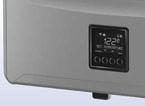


SpacePak, Westfield, Massachusetts, announced the latest addition to its inverter series line of Solstice air-to-water heat pumps — the Solstice Inverter Extreme. The Solstice Inverter Extreme (ILAHP) is an inverter-driven cold climate air-to-water heat pump that provides hydronic heating, cooling, and DHW, without the use of fossil fuels. It features an inverter-driven compressor, inverter-driven fans and fan motors, and enhanced vapour injection technology. The heat pump can heat in outdoor temperatures as low as -30 C, while delivering water temperatures as high as 54 C. The unit comes equipped with a flexible control platform and outputs in all climates and conditions.

SpacePak www.spacepak.com
Bradford White, Halton Hills, Ont, announces its Vitraglas tank lining with Microban antimicrobial technology will now be a standard feature on nearly all tanktype water heaters. Vitraglas is an enamel tank lining that provides protection from corrosion, while the Microban technology provides additional product protection by helping to prevent the growth of bacteria, mould, and mildew on the surface of the tank lining. Vitraglas tank lining with Microban is formulated and applied to the water heater tank, head, base, and flue tube, and is then bonded to the steel surface by firing at a temperature of over 1,600 F.
Bradford White www.bradfordwhite.com
Navien, Vaughan, Ont, introduces its NPE-2 series condensing tankless water heaters, which features an EZNav upgraded multiline control panel with Setup Wizard, up to 0.96 UEF, two-inch PVC venting up to 75-ft, cascade capability up to 32 units, and common vent capability up to 12 units. Like the original NPE, NPE-2 offers dual stainless-steel heat exchangers and a patented ComfortFlow recirculation system with a built-in pump and buffer tank on the NPE-A2.

Navien www.navieninc.ca

Noritz America, Fountain Valley, California, introduces its new NRCR residential condensing tankless water heater series. It uses a fully integrated pump to keep hot water close to all outlets in the home. The auto mode learns the household’s water usage and automatically triggers recirculation-loop activation in line with the expected usage. Available with inputs of 165,000 btu/h and 199,900 btu/h, the new HRCR series carries a uniform energy factor (UEF) of 0.97, while offering the durability of dual, stainless-steel heat exchangers.
Noritz America www.noritz.com
Bosch Thermotechnology, Watertown, Massachusetts, introduces two additions to its electric tankless water heater lineup. Bosch’s new Tronic 4000 C (pictured) is ideal for pointof-use, under-sink installations, while the Tronic 6100 C is ideal for whole-house applications. The Tronic 4000 C measures only 8.5-inches by 13-inches and weighs 4.4 pounds. It can be wall-mounted directly under the sink and requires no venting. The Tronic 4000 C comes in four model options: 3.5 kW, 6.5 kW, 8.5 kW and 10.5 kW. The Tronic 6100 C features a stainless-steel canister inside the unit, which heats up the water but doesn’t store water like a traditional tank water heater. It measures 13 1/4-inches by 20 1/4 -inches and comes with 3/4inch NPT fittings for both cold and hot water connections.



Bosch www.boschheatingandcooling.com
Rinnai, Peachtree City, Georgia, launches its improved Sensei RSC condensing tankless water heater with intelligent recirculation, eventually replacing RUR models. Its RSC will deliver the same quality come to know with the RUR model, but features advanced Smart-Circ intelligent recirculation technology. With Smart-Circ, external controllers are no longer required to provide recirculation for customers and will learn user’s hot water patterns over seven days. It will then schedule pump and tankless recirculation patterns accordingly. Hot water usage must be greater than 20 seconds to be added to the system’s memory.
Rinnai www.rinnai.ca
Decarbonization has officially made its way into the water heater market. The Canadian federal government has changed the standards and regulations in recent years for water heating, pushing the minimum requirement for efficiency; and effectively, altering the path the technology was heading.
The big gold belt of domestic hot water remains with storage water heaters; Canadians looking in their basements will likely find themselves with some type of tank unit controlling their hot water system. “In North America, storage units are still very heavily used,” explains Andrew Tran, senior marketing manager at Noritz America. “I would say the tankless market is probably 15 per cent of the whole market. A lot of people ask me who my competitors are, and you’re inclined to talk about other tankless competitors. But really, our competitors are storage tanks because there’s so much more of the pie that everyone can take.”

Efficiencylegislationis largelydrivinginnovation inDHWandtechnicians shouldexpectasurplus ofelectric-basedheating options.Tankless units still make up only around 15 per cent of the DHW market.
That’s not to say that each type of technology doesn’t have its ideal application or installation. For instance, tank-type water heaters typically work in a larger home with greater demands. “You have to make sure your consumer understands in some situations, tankless is not the right option.
the product was largely designed using a European approach, which just wasn’t adaptable to the North American lifestyle, explains Larry Moores, manager of business development for Rinnai Canada.
“If you’re a contractor and you experienced the first wave of tankless water
perspective, have changed a lot as well.”
So, when is it the correct time to choose tankless or tank? Well, it comes down to the homeowner’s lifestyle, explains Euverman. “There’s a lot of factors that go into it all because if you’re going to run back-to-backto-back showers, tankless could be perfect for you. But if you’re going to run three showers at the same time, you’re going to want a tank unit.”

A good rule of thumb to follow, as a contractor, is to count the number of bathrooms within the building. Anywhere close to five, and a tank might be the more ideal option. Another way is to look at the occupancy of the living space. If it’s just a single person or a couple of empty nesters, then installing a storage tank would work just fine.
As previously mentioned, the first wave of tankless water heaters in North America had its problems, which resulted in a slower adoption. Back then, there was quite a difference in the overall cost of a tankless water heater compared to a storage product.
In a huge house with a few rentals, you need atank.Butastandardhousewithacoupleof showers, here and there, tankless is perfect,” shares Chad Euverman, president at Eco King Heating Products.
When tankless was first brought over to North America, sometime during the 90s,
heaters… there’s a lot of new information for you since then.” Moores was a contractor in 1986 and his experience was not-so-positive. “When I first put in a tankless water heater, it wasn’t a positive thing. But since the mid-90s, everything has changed and the products themselves are so much better. Our products that are installed in our homes, from a fixture
Nowadays, the cost between tank and tankless is extremely close. And with governments pushing Canadian towards energy-efficient lifestyles, there are more incentives for homeowners to choose those types of products.
Take a look at the Natural Resources Canada (NRCan) website and search “water
Continued on page “21”
Most contractors are set up with all the things they need to do service and maintenance on tankless water heaters. They carry it around in their truck and can do several in a day.
A benefit of a tankless unit is that it can be installed almost anywhere in the home, opening up space for things like a home gym.
DO YOU NEED?
BEST FOR:
Cast Iron Or Condensing Floor Retrofits
BEST FOR: New Construction Or Condensing Wall Retrofits
















PAIRS GREAT WITH OUR SMART TANKS

Continued from page “19”
heater” in the “directory of energy efficiency programs for home” section. You’ll find over a dozen rebate programs currently operating across the country. Money that would be going directly back into your customer’s pockets. This goes for both tankless and tankstyle water heaters.
With climate change being such a big topic of discussion around the world, this is also shifting the fuel sources for our water heaters. “If you look at the general political climate and if you look at all the talk out in the industry, a lot of the legislation is pushing away from gas," explains Euverman. “That’s why we started to sell electric hot water tanks. We wanted to be in the market where that demand is going to increase.”
And for those who haven’t made the switch to fully electric, it’s coming, “Electrification is pushing us to find other ways as well to present an electric tankless on the market,” said Tran. “This affects us too in some districts of the U.S.; they are banning natural gas products, but that’s pushing us.”
With the ramifications of the pandemic in the forced-air heating sphere, there has been a spotlight pointed directly at indoor air quality. Like the space heating world, water quality is just as important when it comes to domestic hot water heating. Tank units could need to be replaced faster than wanted when poor water quality is pushed into the system, “It is very essential to have water quality that falls within the parameters or the specifications of any manufacturer,” says Euverman.
Scale can build up over time on tankless
and regular maintenance is needed just as with a tank unit. As such, it is important to make sure customers keep up with regular maintenance. Tankless water heaters should have its heat exchanger cleaned regularly. “It’s really unusual for people to clean tanks, although it’s recommended to look at the maintenance guidelines,” explains Moores. To clean a heat exchanger, all that’s needed is table vinegar. It typically takes anywhere between 30 to 45 minutes. “Most contractors are set up with all the things they need to do service and maintenance on tankless water heaters. They carry it around in their truck and can do several in a day.”
With electric storage tank water heaters in particular, the anode rod needs to be a part of the maintenance checklist. “Every couple of years, the installer technician should be coming back for a service call to look at the tank and make sure that the anode rod is still intact and if it isn’t, you’ll need to replace it,” explains Euverman. Maintenance should occur every year or two on both types of water heaters.
Regular maintenance is important to ensure the lifespan and efficiency of a storage tank water heater reaches its full potential.

New builds are typically easier to install any type of equipment, with equipment typically built around each other. Retrofits on the other hand tend to be a bit more challenging. Tankless manufacturers have come up with innovative solutions to make installation a bit easier on the technician. Some units now have a top-mounted connection, which reduces installation time. “We’re starting to see that kind of trend in the tankless market, where they’re starting to make top-mounted connections or connections that are both top and bottom mounted,” explains Tran. “That is sort of a trend now because I think installation time has been a big barrier for plumbers. Some plumbers are just used to throwing in another storage tank. Now with these options, it’s becoming a little more accessible for everyone.”
The most difficult part of any type of retrofit, whether tankless or tank, would be if the home was switching fuel sources. If it’s going from gas to electric, the breakers need to be tested to make sure it can handle the power draw from the new piece of equipment.
If a homeowner is going to a gas-fired unit, then the venting would need to be changed a little bit and the gas lines need to be tested to ensure that they are also the correct size.
“There are definitely some more steps involved with a tankless. That being said, for most installs, people can replace it quite fast from a tank to a tankless,” says Euverman. :
There is an artistry when it comes to hydronics. Every component of the system is placed together, creating a masterpiece. That isn’t to say that there aren’t any miscalculations or misapplications. In the previous issue, we highlighted some of the most common “party fouls” that I have seen over the years. We are going to cover a few more in this issue.

I am still seeing applications where copper stock manifolds are used for hydronic heating systems. When I was still doing installations, I used them because I frankly didn’t know better.
Let’s assume we have a bungalow with four rooms — two rooms need 10,000 btu/h and two of them need 30,000 btu/h. How are you going to make sure the flows are right with a copper stock manifold? You can’t.
CSA B214 14.3.4 clearly states that when we do these installations, we need to ensure proper design flow rates are achieved. That is a tough task with every room needing a different flow rate and no manifold balancing valves. Just about every manufacturer makes balancing manifolds, so there are lots to choose from.
One of my original mentors used to always tell me, “This is how we have always done it; nobody has ever complained.” The reality is repeatedly doing it wrong doesn’t make it right. Just because they never called me back to fix it doesn’t mean it worked. My competitor very likely went in and fixed it, which is why I never heard about our system’s problems. Don’t let this be you.
Take advantage of technology, like PP-RCT piping that is taking Canada by storm and has been used extensively across North America. Typically, you weld PPR pipe using socket fusion or butt fusion but now, with the advent
Sometimes paying more upfront will help decrease the monthly cost of a system for the lifetime of the home.
of electrofusion, you can fuse pipe up to 12-inches in quite literally minutes with ease and no previous knowledge outside of a quick training session. Always look to see what new innovations are on the market. I recently had the pleasure of visiting a manufacturer who is making preassembled primary/secondary headers in stainless steel. Not only does it look stunning, but it is also surprisingly costeffective and much faster than piping a primary/secondary yourself.
As for the topic of closely spaced tees,
if you can decipher the problem.
The last load return water is coming back at 115.8F. What would happen if we had installed a hydronic heat pump only capable of producing 130F water? The complaint will be that the emitter on the far right of my drawing will have water temperatures that are too low to heat the space and the end user will be cold.
they have been used for longer than I have been alive. They can be harmless in the right application, but technology has evolved, and it does require some thought and at times can be a problem. Look at the example below and see


During the winter, the system worked perfectly, but the building owner complained that all summer long the front lobby radiators were smoking hot. Look at the way that the indirect is piped in. It works great in the wintertime, but all summer long, we are pumping heat all through the secondary piping and can end up with heat going out into the building if thermal traps and check valves are not being used. This is exacerbated by an external control that was bringing pumps on; although the boiler was off due to reset heating, the heat from the indirect was getting pumped around the building.
The other thing I want to note is the potential temperature drop across the loads.
This is a topic I discuss frequently while doing training. When it comes to hydronics, we sometimes instinctively rule out more expensive options because we think we won’t get the work or the homeowner won’t want it. Let the customer decide. Sometimes paying more upfront will result in paying less each month for the life of the home.

Don’t imply your own budget constraints on the consumer; give them options so they can choose. I know that I myself am quite guilty of this and actively work to not put my own budget limitations or design preferences on consumers/contractors/engineers that I have just met.
Air vents and high-efficiency air separators are not the same. When I started working at Eden Energy Equipment and met Bob ‘Hot Rod’ Rohr, it was my first introduction to a
Continued on page “25”

Just because they never called me back to fix it does not mean it worked. My competitor very likely went in and fixed it, which is why I never heard about our system’s problems.Electrofusion allows for pipe up to 12-inches to be fused in minutes with ease.
Closely spaced tees have been used for longer than I have been alive.Investing money in more costly technology upfront could save the homeowner in the
long run.


Continued from page “23”
high-efficiency air separator, and I felt like I had been punched in the gut. I learned more in an hour talking to Bob then in five years of working in the field.
We sometimes wrongly assume that when we commission a system and purge out the obvious air, our job is done. The reality is that as the water heats up, we are going to be squeezing out the entrained air in the system.
Often, I will hear that dirt separators are not getting used because the contractor has never had a boiler heat exchanger fail or they are putting in potable water.

Scale will coat your heat exchanger and cause blisters and failure. Before that happens, it is also negatively impacting your boiler's efficiency because that sludge gets baked right into the heat exchanger impeding heat transfer. I’d suggest paying for the dirt separator, which protects your boiler from not only failure but a drop in fuel efficiency or paying for more fuel for the life of your new boiler and crossing your fingers it does not fail.
Often, we see designs done where a building needs 500,000 btu/h and the designer will spec a single boiler to cover the load. In many scenarios, two smaller boilers are better than


Table provided by
one. Immediately out of the gate, two boilers give you redundancy and no fear of leaving a building completely without heat.
A few years ago, I worked on an apartment facility project. The boiler we took out was an old 500,000 btu/h boiler. We replaced it with two boilers that could meet the required capacity. By doing this, we not only gave them redundancy but we also increased the turndown ratio. Now in the shoulder seasons, we can lower our firing rate to as low as 10,000 btu/h. While in the dead of winter, we utilise the full power of both boilers.
We also do this exact same thing using a hydronic heat pump with a backup electric or gas boiler to cover the domestic hot water and the coldest years of the day. :
Hybrid systems provide backup heat on the coldest days of the year when a heat pump can’t quite meet the homeowners needs.
Photo provided by Kevin Schmitt
Michael Ridler is a technical services manager at Eden Energy Equipment. He started out working for a Ont-based HVAC company and now focuses on providing field support and technical training to contractors, engineers, and builders on heat pumps, boilers, and all things hydronics. He can be reached at edenenergymike@gmail.com

As water heats up, entrained air will be squeezing out of the system.
CaleffiAn IBC combi boiler that had not seen service in a few years. Bryan’s Fuel of Orangeville was called to the site and was able to clean this heat exchanger before it resulted in catastrophic failure.


Experience Viessmann reliability with the convenience of electric heating.
+ No combustion with only electric heating elements
+ Plug-and-play small appliances that can be installed practically anywhere
+ Fast and simple installation with no venting and gas connections required
+ Low maintenance with fewer moving parts than gas/oil boilers
+ Various output ranges & sizes (4 to 14.4 KW) make an ideal solution for energy-efficient homes

+ Quiet operation can be installed in the most noise sensitive areas
For more information

electric heating solutions made easy
Ridgid, Elyria, Ohio, introduces its new battery-powered 760 FXP Power Drive, a hand-held cordless threading tool. Powered with the tooling company’s FXP technology platform, the battery-powered tool can thread 1/8-inch to two-inch pipe. The portable threader’s brushless motor can complete up to 30 two-inch threads per charge. It is available in two variations, 12-R and 11-R, and is ideal for new construction and repair applications on mechanical, electrical, plumbing, HVAC, and oil/gas projects.


Ridgid www.ridgid.com
DeWalt, Mississauga, Ont, announces its new Impact Connect system — a new line of attachments to convert select impact drivers. It features two new attachments: a copper pipe cutter attachment and a PVC/PEX pipe cutter that connects to select DeWalt 20V Max tools and other pro-grade 18V impact drivers. It is ideal for pipe fitting, plumbing, HVAC, and home renovation. The copper attachment features a 1/2-inch and 3/4-inch cutting wheel optimized for cutting performance and speed, and the PEX features up to a two-inch cut capacity in schedule 80 PVC.

DeWalt www.dewalt.ca

General Pipe Cleaners, McKees Rocks, Pennsylvania, launches its Hot-Shot Pipe Thawing Machines. It can thaw pipes in minutes, without tearing up floors or walls, digging around pipes in frozen ground, or using hazardous blow torches. The Hot-Shot 320 can thaw up to 100-ft. of 1-1/2-inch pipe and weighs 30 pounds. The Hot-Shot 400 can thaw frozen lines up to 175-ft. and 1-1/2-inches in diameter. The 400 model features a dual level output that lets users switch to 320-amps and pulls just 14 amps. To use, just attach the clamps to the frozen pipe section and plug the machine into any 115-volt outlet.

General Pipe Cleaners www.drainbrain.com
Fieldpiece, Orange, California, has announced the addition of its CAT85 combustion analyzer to its growing line of products. The CAT85 can accurately measure O2, CO, CO2, and draft pressure and has a built-in manometer. It can also automatically separate and return accumulated water to the flue using its patent-pending HydroCycle pump technology. Along with a fouryear sensor warranty, the CAT85 HVAC combustion analyzer features patent-pending SensorVault technology that extends sensor life by sealing the sensors from oxygen in the air during storage.

Fieldpiece www.fieldpiece.com
Bend pipe easily
Navac, Lyndhurst, New Jersey, introduces its brand-new tubing bender. The newest addition to the company’s BreakFree of cordless tools, its NTB7L power tubing bender is designed to make typically time-intensive chores simpler. Suitable for seven tubing sizes, ranging from 1/4inch to 7/8-inch, the tubing bender allows soft ACR copper to be bent to any desired angle up to 90-degrees via a single press/release control switch, and offers O.D. size changes in seconds. Upon a completed bend, the unit’s baffle automatically ejects the tubing while the tool resets. It can power more than 100 bends per charge and can be fully recharged in 30 minutes. Navac also offers a separately sold NTBRK reverse bending kit.
Navac www.navac.com
Esco Tool, Holliston, Massachusetts, introduces its Dictator II Millhog pipe beveler to market. It is an I.D. clamping welding end prep tool that aligns using self-centering clamps and can incorporate four blades in order to bevel, face, and bore or create a compound bevel. Featuring an adjustable tool post for indexing the blades, it can perform 37.5-degree to 10-degree compound bevels on a 24inch O.D pipe with a two-inch thick wall and is offered with air, electric, and hydraulic powered motors. The Dictator II Millhog uses one mandrel and a set of three wide clamps that provide six points of contact to the pipe I.D. to mount rigidly and ensure chatter-free operation.
Esco Tool www.escotool.com
As residential replacement furnace and air conditioner companies, we have become prone to using the term system loosely, no pun intended. We tend to go about our business convincing consumers that our system is the most efficient system on the market. We throw around acronyms like AFUE and SEER as if they mean something that delivers optimum savings to the home, when in fact, those ratings should be referred to as potential AFUE or potential SEER. Now I am not looking for a fight, but rather reminding
us that a system doesn’t stop at the plenum.
If we were to use the human body as an analogy of a system and compare it to a home comfort system, we would find several similarities, such as the heart with a furnace; air conditioner or heat pump with the lungs/ air filtration; purification with the liver or kidneys; supply run with the arteries; return air with the veins; and lastly, the intake and exhaust with the mouth.
We are all aware that a healthy, happy body requires all parts to function harmoniously. The heart alone is only one part of the system, and a 100 per cent efficient heart isn’t enough to properly sustain a healthy body. Our focus in this article will be on the arteries and the veins.
While most contractors measure in AFUE or SEER, National Comfort Institute (NCI) certified professionals use what they call either a heating system efficiency rating (HSER) or a cooling system efficiency rating (CSER). Both are the efficiency rating of your installed system, including the effects of the

Like the human body, each component of the mechanical room needs to be fully functioning to achieve the
ducting and the construction of your home. Typically installed equipment operates at 55 per cent to 70 per cent of rated capacity. An NCI-trained and certified contractor will field measure the installed efficiency of the current system. As a contractor, you should recommend improvements while installing the new equipment, such as duct sealing and insulation where possible. Once completed, you should test again and prove the value with actual energy savings.
AIR LEAKAGE
“It doesn’t matter if we have air leakage, all the ductwork is inside the home, so why should I worry about it?” Have you ever had a homeowner ask you this?
These leakages cause an imbalance in airflow and create hot and cold spots throughout the home, making it very uncomfortable.
A way to test this would be with a simple pocket thermometer. While the system is run-
ning, insert the thermometer into the plenum above the furnace and record the temperature, then, insert your pocket thermometer into the supply air grill and record the temperature. Now divide the latter temperature by the plenum temperature and you will see
You can use this formula to calculate energy-saving opportunities for central air conditioning as well. NCI reports that it is not uncommon to find 14 SEER air conditioners acting and performing equal to that of a seven SEER.

While duct sealing is part of the solution, it can also be part of the problem. Before doing any sort of duct sealing, we need to search for damaged ducts, inspect pipes that might be flattened in joist spaces, locate fittings that have come apart, and determine if ducts have been sized correctly. Is there enough return air? Without remediating these items first, you will not get the benefit of sealing.
the energy loss percentage.
For example, 26c divided by 49c is 53 per cent of energy making it to the register. If you were to do every register in the home, the average may be somewhere around 60 per cent. The HSER would be equal to a 59 per cent efficient furnace, or conversely, our potential energy savings opportunity could be over 40 per cent!
Typically, we look for high wall returns in each room, especially on the second floor. This is one of the easiest fixes and can usually be accomplished by another return with a
Continued on page “31”
It doesn’t matter if we have air leakage, all the ductwork is inside the home, so why should I worry about it?The furnace could be considered the heart of the system.


















Continued from page “29”
damper directly above the existing sidewall and replacing the current grille with one that has a damper.
If it already has an existing floor return against a wall, sometimes, by gently removing the baseboard and cutting out the base twoby-four, it can create a cavity to supply the high wall return, utilizing dampers.
Dislodged fittings can be a bit tricky. However, with the use of rope and two people (and a little bit of patience), it can be pulled back together. By feeding the rope through the duct and having one person on each end working the rope back and forth while pushing or twisting, the pipe can get the fitting back in place. Another option is to run a bypass around the problem area and create a drywall chase if it can’t be done out of sight.
Another use for a rope and thimble is for crushed pipe. Pull the thimble through the damaged area to improve airflow. Plan B is
the bypass option, which was also used for dislodged fittings.
When wanting to add additional return air, simply think of the common rule of thumb — what goes in must come out. Adding returns to areas of concern can be a simple solution by using joist spaces and closets to get the returns where needed. Take advantage of turning vanes wherever possible. Not only does this improve airflow but it also improves coverage of an air filter.
When it comes to too small of a supply,
it often is easiest to run a new run and, where possible, use ceiling chases to hide the run. Another alternative is to provide an extra run to the room to provide the proper CFM.


Dips and dives
Check for the proper suspension of the duct. The perimeter pipe should create a smooth flow and shorten runs whenever possible. You are now ready to seal the system. We want the air, or rather the blood in our analogy, to stay inside the airway and all the return air coming in from the proper location. Once completed, test the system and congratulate yourself on a job well done. And most importantly, share the new results with the homeowner. Even a 20 per cent increase in energy savings is something to brag about. :
Glenn Mellors was born into a plumbing family and started in the industry in 1973. He entered the HVAC side of the business in the 80s, working in wholesale, and then joined Lennox in 1992. In 2008 he joined the ClimateCare Cooperative Corporation, an Ontario contractor group, where he is director of training and implementation. Glenn can be reached at gmellors@climatecare.com.




Carrier, Charlotte, North Carolina, introduces its all-new AquaSnap 30RC aircooled scroll chiller featuring Greenspeed intelligence and R-32 refrigerant. The AquaSnap 30RC was designed with a new compact tier unit. The optimizations boost the integrated part load values up to 18 for a wide range of applications from 60 to 150 tons. It is ideally suited for office buildings, schools, data centers, hotels, hospitals, and any other application where quieter operation is required. This new model features variable frequency drives for the fan motors and PIC6 controls. Carrier www.carrier.com
Nortek Global, St. Louis, Missouri, announces the release of three new capacities for the Reznor UEZ condensing gasfired unit heater. It now comes in 55, 85, and 110 MBH and is certified for industrial/commercial use, and residential, non-living space applications. It has a 93 per cent fuel efficiency for cost-effective operation.


Reznor www.reznorhvac.com

Weil-McLain, Burr Ridge, Illinois, introduces its Eco Tec Series 2 residential boiler. Featuring the same components, features and accessories as the original Eco Tec unit, the Series 2 features integrated control software that allows for multiple boiler configurations without needing third-party controls. Designed to meet residential replacement applications, it has a 95 per cent AFUE rating. Additionally, the Series 2 has a stainless-steel fire tube heat exchanger, built-in zone control and heating system pre-sets, and is available in four heatonly sizes ranging from 80 to 199 MBH and three combi-version sizes of 110, 150, and 199 MBH.

Weil-McLain www.weil-mclain.com

Greentek, Bouctouche, New Brunswick, releases three new product lines of mechanical ventilation products — the Solace Heat Recovery Ventilator (HRV), the Premier Heat & Energy Recovery Ventilator (HRV/ERV), and the Profile ERV. The Solace top-ported HRV features five models and offers 80 per cent heat recovery. The side-ported Premier series of HRV/ERVs feature five models and is designed for single-family homes. The Profile ERV has been designed specifically for areas where space is at a premium. To balance a Greentek HRV/ERV, the only requirements are a manometer and an STS 2.0 (four wire). Set the exhaust fan speed and the supply fan speed of the HRV/ERV to complete the balancing procedure. The supply and exhaust offset values will be proportionally applied to low and medium speed as well.
Greentek www.greentek.ca
The biggest change coming to the HVAC industry is recertification to UL 60335-2-40. Intertek can help manufacturers during the transition period.

Canadian refillable cylinders available
Solstice N40 (R-448A) offers 5-10% lower energy consumption, a 68% reduction in global-warming-potential and lower environmental impact on the planet. Solstice N40 is approved for use by all major compressor and component manufacturers, and is a near-drop-in replacement for R-404A, allowing for easier installations and conversions. Talk to us today to find out more.
For more information visit: https:www.honeywell-refrigerants.com or Call 800-631-8138



Refrigeration projects that have been designed somewhere between commercial and industrial have been described as “com-dustrial” — a term that’ll hopefully fade from existence.





 By Greg Scrivener
By Greg Scrivener
The interest in CO2 installations in industrial applications has risen in recent years.


The difference between commercial and industrial refrigeration is being blurred more than I can ever recall. The main reason for this is the increasing prevalence of carbon dioxide (CO2). The fact that it started in the commercial refrigeration sector means that it is expanding with the same manufacturers and contractors into the industrial sectors. The ridiculous portmanteau “com-dustrial” is sometimes used to describe systems and equipment that are in between the two. This discussion begs the question – what exactly is commercial refrigeration? What exactly is industrial refrigeration?
Two sides of the same coin?
The first thing to consider is why we might want to distinguish these two types of applications/ industries in the first place.
I think it is obvious to most people that designing and building a refrigeration system with an extremely large capacity is very different than designing something very small. An


Continued on page “37”














Continued from page “35”
ammonia refrigeration plant with a capacity in the 1,000s of tons of refrigeration (TR) is massively different than your restaurant walk-in cooler that might be a ton or two at most. The refrigeration cycle is based on the same scientific principles, but the technology used to achieve the refrigeration can be very different and the skill set required to design and service the systems are different. Industrial is not necessarily better than commercial, but they are different.
This difference has resulted in a divergence over time that has caused a bit of a split in the industry. Are you an industrial refrigeration mechanic or a commercial refrigeration mechanic? Having done both to some extent (you could maybe call me a com-dustrial refrigeration mechanic but please don’t) and having spent years designing and analyzing industrial systems and large or missioncritical commercial systems, I can tell you that there is an application suited to most types of equipment and no magic bullets.
While there is, of course, no clear line between commercial and industrial, and there has never been, certain parameters can lead to a better understanding of the landscape.
As was already mentioned, the size of refrigeration systems can vary by several orders of magnitude. It is true that you could do a large amount of refrigeration with a whole lot of small units — this is sometimes done. This type of solution definitely improves redundancy as one or two system failures don’t have a large effect on system capacity,
but it can get silly. I have seen warehouses with more than 20 condensing units and evaporator pairs installed. Another common challenge is maintenance. It’s hard to notice
industrial solution. There are many reasons for this, but as an example, large and rapid temperature changes can easily damage less robust components and large and rapid load changes often require the ability to mitigate system upsets and manage high liquid flood-back. You tend to see more industrial equipment in more demanding environments.
when one of the systems isn’t working well. Conversely, it would make no sense to put an open drive reciprocating industrial compressor on a one TR walk-in cooler as the cost would be astronomical.
Another place you see the difference between industrial and commercial equipment is application. Some applications, like product freezing, can be extremely demanding on equipment and are more suited to an

Many restaurants and grocery stores turn over their refrigeration every 15 to 20 years or less, while a large industrial production facility may be intended to last 40-plus years. This extended lifecycle leads to a willingness to invest in equipment that is more robust and will last longer. Of course, this is not to say that industrial equipment doesn’t fail, but it is typically designed to be overhauled and repaired repeatedly. It is not abnormal to see a well-maintained industrial plant installed in the 1990s still running today as if it’s almost new.
This lifespan is also why you see a
Continued on page “39”
Industrial is not necessarily better than commercial, but they are different.A frequent location for piping and pipe joint failures can be found at discharger headers on compressor rack style systems. This CO2 rack style system is intended for an industrial application.







































The lines between commercial and industrial applications have never been more blurred than it is today.
Continued from page “37”
willingness to use industrial-style equipment in civic infrastructure projects, like ice rinks. Ice rinks are not an overly large refrigeration system. You can make ice with anything from ground source heat pumps, commercial style chillers, grocery store racks, CO2 racks, to open drive ammonia or halocarbon systems. While people do employ all these options regularly, the majority of municipal projects are still built with an industrial-style system because municipalities have the desire to build facilities with much longer life cycles than much of the private industry.
Another differentiating factor is reliability. I am aware of industrial refrigeration systems that run for years between shutdowns; there are some that have quite literally never been completely shut down in their entire existence except for during a power outage. Repairs and replacement of components, of course, but not shut down. In many large food production facilities, a shutdown is massively expensive, and money put into reliability and long-term operation is much preferred over less expensive investment in equipment.
One example of increased liability is related to the piping design. Smaller commercial equipment is not often built to comply with ASME B31.5 and instead relies on a UL rating for its pressure containing components (other than pressure vessels). This is not bad, but since UL is a test-based method compared to ASME’s much more conservative calculationbased methods, the commercial equipment does experience (in my experience) a significantly higher rate of piping and pipe joint failures. A frequent location for this is discharger headers on compressor rack-style systems. This pipe can get very hot and often doesn’t incorporate appropriate flexibility into
the piping design.
I have seen dozens of cracked discharge headers or failed discharge branch piping in commercial rack-style systems in both CO2 and halocarbons. I don’t recall ever having seen failed/cracked discharge piping on a system that complies with ASME B31.5.

As with many things in engineering or design, it comes down to lifecycle costs. I once worked on a facility that insisted on planning everything — including the spiral freezer and refrigeration system — on a five year life. They had their business reasons for doing this, and I can assure you it doesn’t make sense to use the most expensive equipment in this scenario.

Only a thorough understanding of the owner’s needs can help guide how “industrial” or how “commercial” you make the equipment. The closer you get to the grey area in between them, the harder it is to know what the right decision is. And as I mentioned at the beginning of this article, CO2 is upsetting the long-standing industry
balance. There is a huge interest in using CO2 in industrial applications – and we are – but the systems are still often more “commercial” and don’t have many of the benefits that the old stick-built ammonia and R22 systems did. Over time this will change; it is changing. But in the meantime, we should all work together to make sure the word com-dustrial dies. :
Greg Scrivener is the lead refrigeration engineer and a partner at Laporte Consultants, Calgary, and works throughout Canada and the U.S. He is a professional engineer and journeyperson refrigeration mechanic. He can be reached at GScrivener@laporteconsultants.com.


In memory of Jon Leeson

Francois Deschênes, president and CEO, issued a note to Leeson, “During all these years that I have known you, I always felt that you wanted to go for it, to persevere despite the pitfalls and that you said things as they really were with honesty and sincerity. All this with your sense of humour, your humility, and your desire to put others first rather than yourself.”
During his time in the industry, he held various marketing and sales roles before becoming vice president and general manager. Leeson was also long involved with the Canadian Institute of Plumbing and Heating (CIPH).


In tribute to the nearly 20 years of work at the Deschenes Group,

Leeson passed away on Dec. 15 after a lengthy batter with cancer. He leaves behind his wife of 29 years, Linda Leeson, and his two children, Madison (Yazeed) and David.
Funeral details will be announced at a later date. Leeson would like for those interested and able to make donations in his name to the Sinai Health Foundation in Toronto. A page has been set up on Arbor Memorial for people to share condolences.
Sluyter announced that Melissa Barrett had joined its team as the new marketing manager. Barrett has more than 13 years of experience in business, marketing, sales and management. She previously worked at Evolve Home Services

Angela Grieb has been named as the new assistant national sales manager at General Pipe Cleaners. Grieb has been with General for 17 years, which included working as an executive sales coordinator.
Blanco has appointed Diana Windsor as its senior vice president of sales for North America. Windsor has more than 13 years of sales and management experience in the plumbing industry. She previously held senior leadership roles at Watts Water Technologies and Kohler.
Cam Giroux has joined Barclay Sales serving as its mechanical and hydronic specialist. Giroux has owned his own hydronics installation company and has been in the industry for more than 17 years.

Johnson Controls has appointed Lei Schlitz as its vice president and president of global products. Schlitz will lead the global products business and will be based in Milwaukee, Wisconsin. She joins from Illinois Tool Works.


Viessmann has three new additions to its team: Joshua Burns , Tarandeep Singh , and Jeremy Manalo Burns will act as the marketing coordinator in Waterloo, Ont. Singh will serve as the territory sales manager in Langley, B.C. While Manalo will op erate as the logistics coordinator in Langley as well.

Canadian General Filters Ltd. announced that Sam Argentino would serve as its new president. Argentino brings over 33 years of senior management experience.

Latisha Rathell has been announced as Bradley Corporation’s new director of customer service. Rathell brings over 20 years of experience in financial and business analysis, reporting, project management and contract performance management roles.

NTI Boilers announced that Kyle Silvio will be joining its team as regional sales manager in the Massachusetts, Rhode Island and Connecticut areas. He is a licensed journeyman plumber with previous employment as a service manager at a Massachusetts heating company. Silvio has previous sales representative experience and was a condensing boiler technical trainer at a manufacturer’s representative agency.

At Bradford White, innovation is important. So we’re proud to introduce the Infiniti® GS and GR tankless water heaters which offer the energy-efficiency, high-performance and cutting-edge features you and your customers expect.













• RESIDENTIAL AND COMMERCIAL.
• OUTSTANDING RELIABLITY. Robust stainless steel heat exchanger for longer life.


• POWERFUL PERFORMANCE.
11:1 turndown, high GPM output of 5.1 GPM at a 77°F rise. High temperature setting – up to 180° F (Infiniti® GS).




• REMARKABLE FLEXIBILITY:
• Available in natural gas or propane
• Indoor or outdoor (with outdoor kit)
• Available as standard model (Infiniti® GS): Cascadable up to 16 units, common vent up to 8 units





• Or with built-in recirculation pump (Infiniti® GR)




Saniflo has announced the addition of three new business development managers, covering sales territories spanning most of Canada. Richard Legault has been named business development manager for Eastern and Central Canada. Based in Cornwall, Ont, he will serve wholesalers, contractors, and engineers in Ontario, as well as in Quebec and Manitoba. Trevor Reeve will serve as business development manager for the greater Toronto area, as well as Southwestern Ontario. Based in Kitchener, Ont, he will call on wholesalers, contractors, and engineers within his sales territory. Justin Cooper is the new business development manager for Western Canada. Based in Edmonton, Alta, he will focus on wholesalers in Alberta and British Columbia.
Oatey Co . announced the promotion of Paul McKay to vice president of Canada. In his new role, he will lead the daily operations of Belanger(Tubular Industries of Canada), in addition to his existing responsibilities for G.F. Thompson and Oatey Canada SCS. McKay came to Oatey when the company acquired G.F. Thompson in 2016. Since then, he has held the position of director of manufacturing and distribution for Canada; and, most recently, general manager of Canada, overseeing company operations for G.F. Thompson Company and Oatey Canada SCS.
pany to Infinitum . As part of its rebrand, Infinitum secured $30 million in growth capital to expand and fully automate its production facility in Mexico.
DiversiTech announced the formation of DiversiTech Europe via a merger with Artiplastic of Milan, Castel Engineering of Belgium, and Rodigas of Padua, Italy, along with the existing DiversiTech/ Pump House business in the United Kingdom.
Next Supply has expanded its operations out of the Greater Toronto Area with a new warehouse location in Kitchener/Waterloo, Ont. The warehouse will be stocked with all the major brands and will have a full inventory of products within the hydronic and plumbing industries. The new location plans to open in February 2023.
Daikin Comfort Technologies has acquired Venstar, Inc , a controls and energy management systems provider.
Saniflo's parent company, SFA Group , has updated it international website. It will now focus on the global vision of SFA’s activities and highlight the corporate’s social responsibilities and values.
NTI Boilers and Laylan Hydronics and HVAC Sales announced that the two companies have entered into a strategic partnership for the Ontario region. Laylan Hydronics founder, Mathew Pottins , has over a decade of experience working in the HVAC industry.


The Master Group announced its acquisition of Fortress Group Inc., which specializes in the wholesale distribution of heating, ventilation, air conditioning and refrigeration products for residential and light commercial applications.

Wolseley Canada is building a market distribution centre in the Greater Toronto Area. The new distribution centre will use robot automation technology and will include a showroom, store, and counter presence for face-to-face customers. Completion is expected by the end of 2023.
Senseware has rebranded to Attune. The rebrand will be an opportunity for the company to create a platform that’s “attuned” to its customer’s needs and configured to their specifications.
A. O. Smith Enterprises Ltd has released its A. O. Smith Academy mobile app for contractors. Through the free mobile app, customers can access the A. O. Smith Academy’s robust resources on their smartphones or tablets.
Infinitum Electric Secures announced it is rebranding its com-



One of the reasons owning a business can be so stressful is that it can be a lonely endeavour. It’s not always easy to talk to about it, particularly when problems arise or when there are plans to take the business to the next level. Imagine having a cash flow problem (an easy problem for most of us to imagine). Who could you talk to about it?
Friends can sympathize, but they don’t know what it’s like unless they have had that problem in their own business. They’re probably wondering if you’re going to hit them up for a loan. Sharing a cash flow problem with a spouse might garner some sympathy, but not a solution and why have them worry?
And your employees could be easily spooked. They’re looking for a leader, not someone they have to prop up, and they don’t like uncertainty involving their pay cheques.
Your suppliers may tighten up your credit levels. Maybe their pricing will creep up too. Your customers will also get nervous, thinking you cannot finish the work. They may be afraid to give you more work and may try to grind you down on pricing. Even worse, they may hold back progress payments and exacerbate the situation. Your bank is only interested when you have more security for them; otherwise, they might call your loan. Worse, they might take the extra security and then call your loan!
My advice is to find someone with whom you can talk freely about business issues

When owning a business starts to feel a bit isolating, turning to a peer support group might help you work through some of the headaches that come with being the boss.
and successes. Your external accountants can offer some advice. Paid consultants or the Business Development Bank of Canada (BDC) can also help. Don’t ever feel that you are in the minority with business problems and loneliness.
Yourbestoptionsaretofind amentor or join a peer group. You will have someone with whom you can spend some time regularly, someone who understands and provides guidance.
When you watch tennis, it’s easy to see it as a “one-on-one” competition, but when you listen to the commentators, it becomes very obvious that the game is more than just those two players trying to defeat each other on the court. Behind those two competitors are teams of trainers, coaches and other support people.
Does it strike you as odd that the top players in the world rely on a support system? If they are that good, why do they need all the support or are they that good because they have all the support? If it works for them, wouldn’t it work for you?
You, like the tennis pro, can’t go it alone expecting victory and championships. You too need a support system.
For example, when deciding whether to go for a run, I look at the weather. When it’s miserable outside, I won’t go unless I’ve committed to running with someone else. I don’t want to let my friend down, so despite the miserable weather (and a lot of muttering and whining), I run. Afterwards, I feel very pleased with the achievement an achievement I would not have made had it not been for my commitment to another person.
Committing to a third party is a huge step in the right direction. It creates a level of accountability which will get you results. Commitmentstoothersarefarmoreeffective than commitments made to oneself.
The right mentor can help you in so many ways, but they can be hard to find.
Another option that has been around for many years, but too few contractors take advantage of, is the use of peer groups. There are several variations on this principle.

Fundamentally, a peer group consists of a group of non-competing businesses that are doing a similar type of work and are of a similar size.
In order for them to be noncompeting, it usually means they have to be apart geographically — having at least one of them in a warm climate with a good golf course is a must.
A model for peer groups that I particularly like include four- to eight-member companies, meetings every two to three months, meeting at each company’s place of business on a circulating basis, and meeting for three days.
The focus of the meeting would be on issues that are very important to each member, but it would primarily be an audit of the host business.
Each company would prepare a binder for its own business and over a period of time complete the binder. There would be sections in the binder for all the major areas of the business — sales/estimating/marketing, finance and administration, human resources, operations, and succession planning.
During the three-day visit to the host company, the business owners would audit how the business operates (maybe over the course of 1.5 days) and then spend the last half-day writing their report (without the host business being represented). This is when you go through the review with the host business. Additionally, this allows time to discuss the previous host company’s progress. There must be a strong sense of accountability, fellowship, and commitment. Other members can also raise issues that are critical to them.
Sometimes these groups bring in outside facilitators but usually manage the process themselves. The cost of the facilitator would be split between all the members. Individual members can always phone and email each other between company reviews. Researching software is often done by these
groups to ensure getting the most suitable applications with the least cost and effort on the part of any one particular contractor.
Sources for getting into a peer group include talking to major suppliers about this concept or raising it at association meetings. HRAI has sponsored several of these peer groups for both commercial and residential HVAC contractors. Maybe you can convince a supplier to start a peer group among its customers. There are also groups like ClimateCare that offer these services to their members.
Don’t get involved with a peer group unless you are willing to participate actively. You will only get great results if you commit to the process. Do participate if you are serious about growing a successful business and creating your legacy. :

Heat pump training will soon be available to the industry. The Heating, Refrigeration and Air Conditioning Institute of Canada (HRAI) is launching its inaugural “Heat Pump Symposium.” Held in partnership with the Ontario Geothermal Association (OGA), the one-day event will be held on April 4th at the International Centre in Mississauga, Ont.
The idea for the symposium, “came out of a discussion with HRAI’s Emerging Trends Committee, which has a mandate to explore emerging trends in the industry and advise on appropriate actions. They felt that there was a need for a more focused discussion and promotion of the unique role of heat pumps in tackling the mammoth task of decarbonization of homes and buildings in Canada,” states Martin Luymes, vice president, government and stakeholder relations at HRAI.
The symposium is geared toward industry members who will gather and discuss the latest technological trends, exchange valuable
March 6 – 8:
HVAC Cold Climate Conference, Marriott Anchorage Downtown, Anchorage, Alaska. For more information, please visit www.ashrae.org.
March 13 – 17:
ISH 2023, Frankfurt Fair & Exhibition Centre, Frankfurt, Germany. For more information, please visit www.ish. messefrankfurt.com.
April 19 – 20:
MCEE, Palais des congrès de Montréal, Montréal, Que. For more information, please visit www.mcee.ca.
knowledge, and share strategies for how the industry can grow and benefit during this transition to a low-carbon economy.
“The OGA is a supporting partner of the heat pump symposium because we’re seeing the shift to heat pumps accelerate now in residential HVAC. This is no surprise as it’s been a plan since NRCan released the 2018 Space and Water Heating Market Transformation Road Map: “Paving the Road to 2030”, where the writing was literally on the wall. As contractors start to shift their businesses and adopt heat pumps, the industry needs to show what tools and supports are available to them,” explains Jeff Hunter, president of the OGA.
Heat pumps have become quite a hot topic as Canada looks to reduce carbon emissions and make buildings more environmentally friendly. “Across Canada, the heat pump is becoming the technology of choice for addressing our most pressing environmental challenges. Whether it’s air-to-air, geothermal, air-towater or other options, heat pump technology is our best bet for addressing Canada’s crucial decarbonization goal while reducing costs and boosting efficiencies,” explains HRAI on its event website.
During the one-day conference, guests can network, attend educational seminars and explore exhibitor booths. Educational seminars will cover topics such as Building the Business-Case for Heat Pumps, Myth-Busting
Heat Pump Misconceptions, Policy Reality, and two keynote speaking presentations. Speakers will include members from Dunsky Energy and Climate, the Ontario Clean Air Alliance, the Toronto Region Conservation Authority, and more.
Between the seminars and networking, guests will be able to explore exhibitor booths, all of which will offer products and information on heat pump technology.
Hunter adds that providing information to contractors is the focus as, “the public should know that the space and water heating electrification transition is now underway, as it is in many advanced economies around the world. From the OGA perspective, our goal at this event is to help inform participants about what’s available for them today to get involved with Ontario’s geothermal industry.”
Eco
Ultra
Intellihot ..............................................4
Triangle
Lyncar ................................................48










